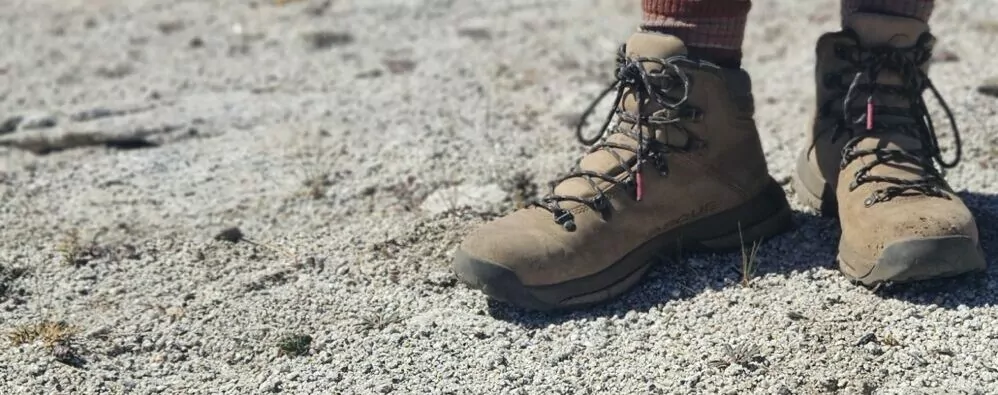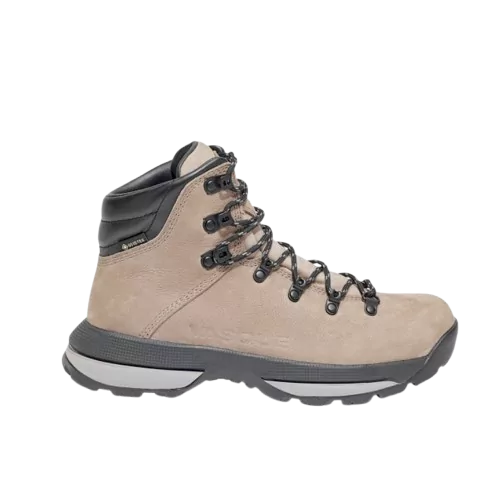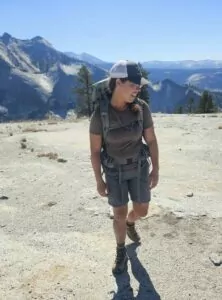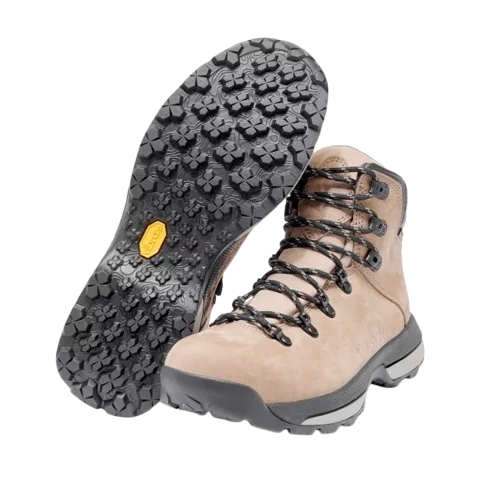Vasque St. Elias Hiking Boots Review
 Don't forget to follow us on Instagram for the latest gear news!
Don't forget to follow us on Instagram for the latest gear news!
Hi, hiker friends! I’m Sasha Jurchak, a full-time hiking guide with Wildland Trekking, leading trips to the Trinity Alps Wilderness and Yosemite National Park. As you can imagine, my personal hiking kit is very important to me, and my footwear may be the most crucial part of that kit. Covering hundreds of miles every year, oftentimes while carrying significant weight in my pack and tackling rugged terrain, a supportive and comfortable pair of hiking boots is critical to my job’s success. Therefore, I was delighted to test the new St. Elias Boots from Vasque during my season.
After leading several trips while rocking the St. Elias boots, as well as heading out on a few personal trips of my own, I’m ready to share everything I’ve learned. This review will start with a broad look at the St. Elias specifications and features; then, we’ll zoom into the specific details of how they performed in the backcountry. So, let’s take a look!

St. Elias Boots QUICK LOOK
To set the stage for this review, let’s start with the basic specifications for the St. Elias boots.
- Price: $230.00
- Boot Type: Over the Ankle
- Material Information:
- Uppers: 1.8-2mm Full Grain Leather (Nubuck)
- Midsole: Dual-Density EVA
- Outsole: Vibram® Megagrip
- Uppers: 1.8-2mm Full Grain Leather (Nubuck)
- Waterproofing: Gore-Tex (100% waterproof)
- Weight (Pair): ~2 lbs. 6 oz.
St. Elias Boots Intended Use
The burly leather build, Gore-Tex waterproofing, and hefty design all scream for intense backcountry adventures. These boots are a classic hiking workhorse, designed to take everything the outdoors can throw at them and keep you moving forward with support and comfort. Significant foot and ankle support make the St. Elias ideal for hiking over rugged or technical terrain, and the Vibram outsole is optimized to provide maximum grip in any weather conditions. You won’t be moving light and fast with these boots, but they’ll take you mile after mile with extreme support, waterproofing, and comfort.
Therefore, the St. Elias boots are ideal for almost any backpacking or hiking trip, from just one day to several weeks in the backcountry – especially if you prioritize support and waterproofing over low weight and flexibility.
Notable Features
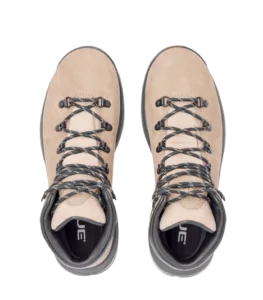
There are a few distinct features that make the St. Elias boots stand out. Let’s take a look at those features in more detail along with how they can impact the boots’ performance.
- GORE-TEX Waterproofing –provides some of the best waterproofing in the industry to keep your feet nice and dry through the elements.
- Leather Uppers – offer an appealing and durable design that looks great on the trail and protects the Gore-Tex layer from damage.
- Vibram Megagrip – is the latest outsole material from Vibram that maximizes the boot’s durability and grip on any surface, no matter if it’s wet or dry.
Vasque Background
Vasque started with W.D. Sweasy in Red Wing, Minnesota, in 1964 with the singular purpose of equipping the fledgling American outdoor industry with heavy-duty hiking boots. Since then, Vasque has built a reputation for providing burly, long-lasting footwear that’s designed to take on the outdoors and keep you moving to bigger and better vistas. Vasque’s bread and butter is the classic leather or synthetic hiking boot or shoe with all the support and cushioning these beasts can muster. But, more recently, Vasque has been dipping a toe into lightweight trail shoes with their new Re:Connect line of footwear.
THE TEST – QUICK OVERVIEW
I tested these boots while leading backpacking trips into the Trinity Alps Wilderness and Yosemite National Park.
Luckily, I encountered some of the best testing conditions for a pair of hiking boots. The terrain ranged from rough, rocky granite to heavily forested areas with temperatures ranging anywhere from 50 degrees Fahrenheit all the way up to 90 degrees. I also got to test the Vibram outsole's grip on slick, fresh snow up in the mountains, and the boots' waterproofing in slushy and muddy conditions as that snow melted.
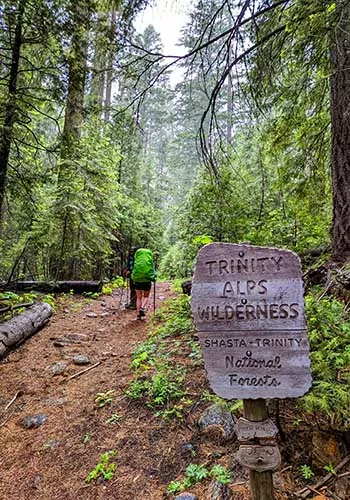
St. Elias Boots Review
We’ve set the scene for this review with the basic specifications of the St. Elias boots and Vasque’s background as a brand. Now, it’s time to dive into the specific review. Below, I’ll list the main performance categories for a pair of hiking boots and give the St. Elias boots a score from 1 to 5. The key for these scores is below, and I’ll give specific details from my test to back up the score I assigned for each category. So, let’s see how these boots did!
Scoring Key:
1/5 – Poor
2/5 – Tolerable
3/5 – Fair
4/5 – Good
5/5 – Outstanding
Comfort – 4/5
Overall, I found the St. Elias boots to be comfortable after they had been broken in.
Break-in periods are very common with heavy-duty hiking boots and refer to the initial, and oftentimes uncomfortable, period when the boot material is slowly adjusting to your foot size and step. This is 100% to be expected with leather boots, and my whole break-in period for the St. Elias boots included four days of wearing the boots around town in non-hiking conditions, then an additional five days on the trail for the boots to truly feel “fitted” to my feet.
After that break-in period, the leather uppers felt very comfortable and supple, nicely forming to my foot shape with minimal rubbing or irritation. However, I deducted one point from this category because I found the midsole to be less comfortable than other boots I’ve used in the past. At the end of a long day on the trail, my feet were definitely more achy than normal, and I attribute this to what seems like moderately low cushioning in the midsole. Granted, as a guide, I’m carrying a lot of weight into the backcountry, which directly impacts my feet, so I’d still like to see some more midsole cushioning.
So overall, the comfort was good but not fantastic. I liked the leather uppers after the break-in period, but I plan on replacing the midsole with a more plushly cushioned insert in the near future.
Durability – 3/5

For a heavy-duty leather boot, I was a little taken aback by how quickly the St. Elias boots started showing significant wear.
From the very first foray into the backcountry, which included rocky mountain terrain, the toe area of the boots immediately took a beating and showed deterioration (see photo). The leather appeared significantly scuffed and even started peeling in a couple of places. Subsequent trips saw this scuffing and deterioration worsen. Hiking is rough on shoes, but I’d expect a premium leather pair of boots to stand up better to regular hiking excursions.
I contacted Vasque customer service about this issue, and the representative I spoke to was extremely patient and helpful as we discussed this issue. Their first piece of advice was for me to remember to condition the leather to help keep it supple and strong – they recommended NikWax leather boot conditioner to accomplish this. I want to stress that this wasn’t a dodge by Vasque, since all leather boots need conditioning for long-term durability, and the representative did assure me that if conditioning the leather didn’t stabilize the issue, they’d want photos and would discuss options with me. I applied conditioner to the boots, and it seemed to help nominally. It certainly didn’t and couldn’t reverse the damage that the boots had already received.
At the end of two months of testing, I can report that this leather scuffing/peeling issue seems to have stabilized and isn’t getting worse. Still, the boot toes look pretty butchered, and the leather appears to be separating from the rubber outsole in that same area – not ideal at all.
Overall, I’m a little disappointed in the St. Elias boots’ durability. The immediate damage to the toe area doesn’t make me incredibly confident in their longevity. I’ve deducted two points in this category to reflect these concerns.
Waterproofing – 5/5
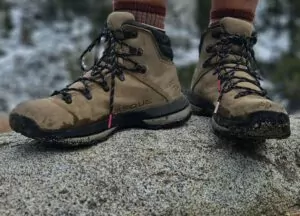
I initially found the waterproofing of the boot to be just ok (maybe a 4/5). This was due to the fact that the leather tended to retain water during creek crossings or rain. My feet would stay dry, thanks to the Gore-Tex, but the leather would get a little sloppy holding on to that water.
However, after I contacted Vasque about the peeling issue on the toe – described in the durability section – they recommended I use Nikwax conditioner and proofer to strengthen the leather. I applied these products, and they made an incredible difference! I could submerge the boots during creek crossings, and the water would bead up, run off, and not get absorbed into the leather at all. The photo to the right, after emerging from a creek crossing, shows this extreme change. Most of the upper is bone dry, while a small section along the rubber (that I likely missed while treating the leather) shows how the leather wants to absorb water when it’s fresh out of the box.
Throughout this whole process, the Gore-Tex layer was fantastic, and it never let any water reach my feet. Additionally, with proper leather care and treatment, the St. Elias boots could shed water very easily. I’m a little disappointed the boots come out of the box unprepared to encounter water, and you need to apply conditioner and proofer to the leather before it can take on the outdoors – a step I wish Vasque had taken during production.
Quality – 4/5
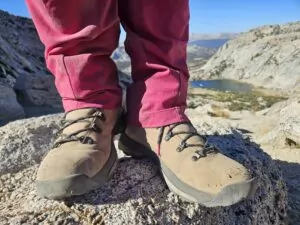
The individual components of these boots appear to be high quality and well put together.
The rubber outsole is tough with excellent traction. The laces and accompanying hardware to hold the laces in place are tough and never failed or popped out. The overall leather quality also seems relatively high and comfortable.
However, the fact that the leather uppers appear to lack much finishing (minimal conditioning and waterproofing, as discussed above), led me to deduct one point from this category. For the price and overall quality of Vasque products, I’d expect a little more effort and conditioning to be put into the leather so they could come out of the box ready to go instead of needing the buyer to apply additional products to them immediately.
Support – 5/5
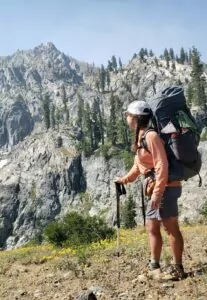
Warmth – 5/5

Leather boots typically retain more heat than their mesh rivals, and the St. Elias is no exception. I found these boots pleasantly warm, and my feet and toes never got too cold during my mountain trips. Additionally, I sized up one size from my normal (I’m normally a 10, and I tested a size 11), and this gave me the perfect amount of space to wear some thick socks when I needed to.
Therefore, top marks for warmth, but this did lead to some minor issues in the moisture control and breathability section, which we’ll discuss next.
Moisture Control – 4/5
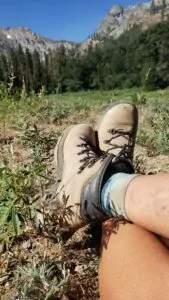
For standard hiking in temperate conditions, I found these boots to have good moisture control and breathability. But as I worked harder or the temperature rose, I did encounter some classic problems pertaining to leather hiking boots.
Specifically, when I got hot or started working hard, my feet would start to heat up and sweat. The leather upper isn’t the most breathable material out there, so heat and moisture would be relatively locked into the boot, leading to some sweaty and damp socks and feet that were screaming to be aired out by the time we got to camp.
Therefore, I deducted a point from this category to represent this potential sweaty feet problem. If you predominately hike in hot climates or know that your feet tend to get extra sweaty when hiking, then some synthetic hiking boots with better moisture control may be a better choice. But for standard mountain hiking, these leather boots are quite good in this department!
Weight/Bulk – 4/5
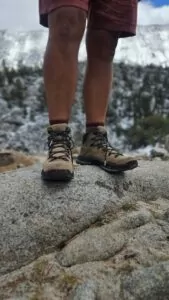
I found the weight to be pretty reasonable for a standard backpacking boot.
Now, that’s not to say these are lightweight boots, not at all. The two-and-a-half-pound weight per pair means that these boots definitely have some bulk to them. But I didn’t find them overly cumbersome, per se. That extra weight brings some great support and comfort that makes it well worth it if you’re looking for a classic hiking boot.
However, if I was heading out for some long-distance or thru-hiking, I’d probably opt for a lighter option in order to maximize my mobility on the trail. But the St. Elias shines for standard three to five-day backpacking trips, and I’d definitely recommend them for this type of use.
Price – 3/5
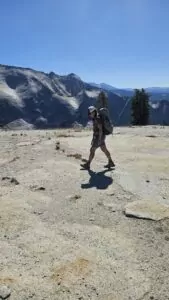
After testing and researching similar boots on the market, I’d say that the price is okay and right in the middle of the pack – not abysmal, but not stellar either. These boots aren’t a budget-friendly steal by any means, but they’re also not delivering the absolute best quality in the industry for the price. They’re right in the middle. Let’s look at why.
For the price and overall quality that Vasque typically delivers, I’d expect this boot to hold up better in rocky and rough conditions (hiking on granite and traversing granite talus fields occasionally). This judgment again stems from the significant damage and wear of the leather in the toe area that showed after my first trip. If Vasque could shore up this area to make these boots truly bomb-proof, I’d say that the St. Elias would then be 100% worth the price and deliver outstanding value. Until that day, I have to stand by my lower score in this category.
Bringing It Together
We’ve covered a lot of ground in this St. Elias Boots review. So, let’s consolidate all the important data points from my test here with some broad pros and cons.
Pros:
- Very comfortable leather upper
- Supportive
- Good heat retention for cooler hikes
- Effective waterproofing
- Fits true to size
- Reasonable weight without being too clunky
Cons
- Leather upper is susceptible to scuffing and peeling
- Leather needs immediate conditioning and waterproofing before heading out on the trail
What is The Vibram Megagrip outsole?
Vibram has been leading the development of high-quality rubber outsoles for decades – since 1937, in fact. From industrial to outdoor applications, Vibram is typically synonymous with premium and nearly indestructible rubber.
Their latest MegaGrip Outsole material is simply the latest iteration as they continue to fine-tune their formulas for the best outsole materials. The MegaGrip, as the name implies, is tailored to deliver outstanding grip and stability on any surface you’d encounter in the backcountry. Wet or dry, rock or dirt, the MegaGrip should keep your boots sticking to every surface while standing up to the rough and tumble world of backcountry hiking.
Final Thoughts
I enjoyed testing these boots and fully intend to continue using them.
The St. Elias boots proved to be supportive and pretty comfortable – after the classic boot break-in period – and the Gore-Tex waterproofing was rock solid on the trail. I’ll probably put some cushier inserts into the boots to further boost the comfort, but overall, I was very pleased with what these boots have to offer. I also liked that Vasque managed to keep the boot weight reasonable for this style of footwear and not make them ungodly heavy and clunky.
My main feedback centers on the leather uppers. Right out of the box, the leather doesn’t have any proofing treatment or conditioning. Before proofing the boots myself, the leather would absorb and hold onto any moisture (the Gore-Tex protected my foot, but the leather would get sodden). Additionally, the leather in the toe area immediately took a beating and showed noticeable damage. Therefore, I’d like to see Vasque apply some waterproofer to the leather as part of their process and perhaps extend the rubber outsole up and over the toe in order to provide some additional protection in this high-wear area.
But despite my points regarding the leather upper, I’m very pleased with these boots, and I’ll 100% keep using them. As a solid and supportive classic hiking boot I can certainly recommend the St. Elias as an excellent choice for most hikers. I just hope to see a few minor design refinements in future iterations.



